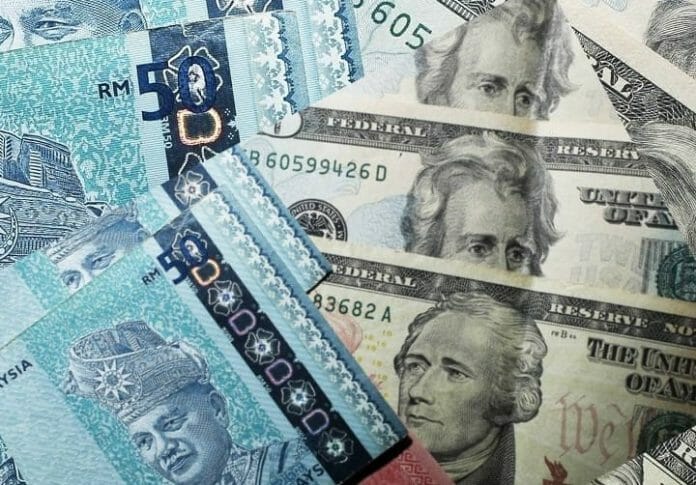As of 26th April 2024, the DXY Dollar Index has risen +3.1% since the end of 2023, peaking at 106.26 on 16 April 2024 after the US retail sales data overshot market expectations.
MIDF Research said today (Apr 29) that inflation remained sticky, supported by the resilience of the US labour market.
The sticky core inflation especially has been a major factor underpinning the USD’s strength. This is evident by how the market quickly brushed off the weaker GDP data after the release of core PCE inflation last week.
Following the weaker-than-expected GDP data on 25 April 2024, the DXY Index declined by -0.2% to 105.60 compared to the previous day but quickly rebounded stronger the next day, increasing +0.3% to 105.94 after core PCE inflation remained unchanged, also exceeded market expectations.
Looking into geopolitical developments, the Middle East conflicts between Israel and Iran, have also spiked oil prices, contributing further to inflation concerns and triggering safe-haven demand. These factors supported the “higher for longer” interest rate setting, and the USD appeals as a safe-haven asset, reinforcing the dollar’s strength amid global uncertainties.
USD strength to subside on Fed’s rate cuts. Currently, the market is expecting a single rate cut of -25bps in the latter half of 2024, which will bring the Fed Funds Rate (FFR) to 5.00%-5.25% range, significantly lower than initial expectations of a total -150bps rate cuts at the start of the year.
This recalibration to a smaller reduction was due to the sticky inflation and has been the main factor underscoring the dollar’s strength.
Nevertheless, despite the so-called “last mile” inflation challenge, US inflation has broadly been on a moderating trend. For example, despite steadying at +2.8%yoy in Mar-24, the core PCE inflation is still significantly lower than the post-pandemic peak of +5.3%yoy registered in Apr-22.
The recent indicators, including 1QCY24 GDP and Services PMI, signal a softening domestic demand. Hence, MIDF foresees the Fed easing its policy interest rate would still take place in 2HCY24, albeit much later into the year; this will eventually lead to reduced support for USD strength.
Ringgit to appreciate on narrowing interest differentials
Year to date, MYR has depreciated by -3.6% to RM4.768 as of 26 April 2024, despite hovering close to the 26-year low of RM4.805, which was registered in Feb-24.
Relatively, the ringgit fared better against the currencies of Malaysia’s major trade partners with our MIDF Trade-Weighted Ringgit Index (TWRI), only weakened by -0.2% to 85.17 with a recent trend suggesting further upside potentials.
Despite expectations of a much slower FFR cuts than initially anticipated, we expect the appetite for riskier assets will improve as the Fed moves closer to rate cuts.
MIDF continues to foresee ringgit and other regional currencies benefiting from the return of foreign fund flows into EM markets especially when the Fed slashes its policy interest rate.
Nevertheless, adjusting to the significantly smaller degree of FFR cuts than initially expected and taking into account the effect of prolonged dollar strength recently, MIDF foresees a smaller appreciation of the ringgit than our initial forecast.
MIDF now expects the ringgit would average relatively stronger at RM4.53 in 2024 (2023: RM4.56) and move towards RM4.43 by year-end (end-2023: RM4.59).
However, considering the much better performance against currencies of major trading partners, especially JPY (+6.4%ytd), THB (+3.4%ytd), KRW (+2.6%ytd) and TWD (+2.1%YTD), MIDF kept their projection for TWRI to end the year higher at 91.50 (end-2023: 85.34).
No rate cut by the Fed will spell another gloomy year for ringgit. If the Fed decides to keep the FFR status quo until year-end, the much-anticipated reversal of fund flow into the emerging markets will be further delayed.
Additionally, if other advanced economies (i.e. Euro area & UK) start to ease their policy rates EM currencies will undoubtedly experience added pressure from the prolonged dollar strength.
However, with the OPR widely expected to remain steady for the rest of the year we did not expect a significant deviation in the ringgit’s performance from the current level at year-end although it will mark the 4th consecutive year of depreciation.
In the worst-case scenario, factoring in no rate cuts by the Fed and the probability of prolonged tensions in the Middle East, MIDF project the ringgit to average weaker at RM4.77 with the year-end exchange rate to be around RM4.74.









